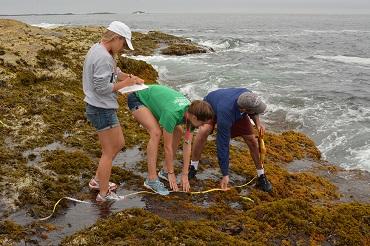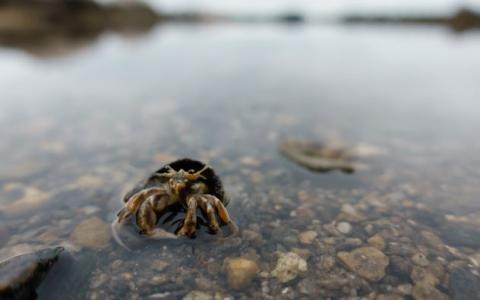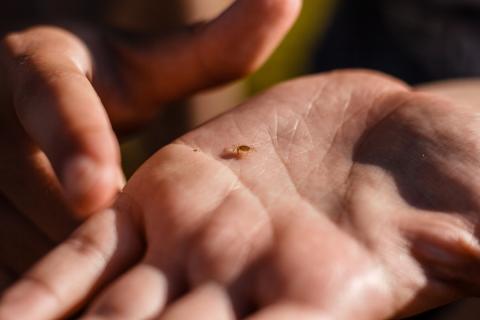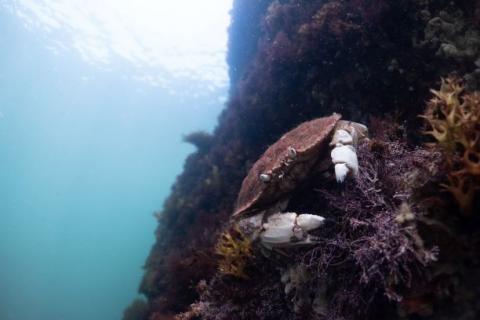
Educational Resources
This summer, SML created on-island science content for our academic courses and to share educational resources around the world! Select videos are available for request here for public and university use, with additional seminars and lectures available to the public on our YouTube page.
Educational content is packaged in privately-listed YouTube playlists, with full descriptions of each playlist included further down on this page. To request access to one or more playlist topics, please click here or the button below to complete the request form. An email will be sent including instruction on usage and links for each playlist. Individual videos can be embedded in PowerPoint presentations, zoom, and most other products. When viewing the playlists, scroll down on the YouTube page to view a descriptive paragraph is provided as context for each playlist and video.
Do you know someone who may find these resources useful? We ask that content is shared between users through the form on the SML Marine Science Resources page for video usage tracking.

This playlist focuses on the zonation of species driven by extreme conditions present in rocky intertidal ecosystems in the Gulf of Maine. Organisms must be tolerant of drastic changes in heat, salinity, and desiccation as the tide ebbs and floods each day.
Use this playlist to demonstrate the observable differences of these zones and the characteristic species that define them.
Playlist includes:
- Intertidal Ecology at Shoals Marine Laboratory
- Intertidal Zonation
- Upper Intertidal
- Barnacle Zone
- Middle Intertidal
- Lower Intertidal
- Ascophyllum Canopy
- Ascophyllum Swim Through
- Green Goddess Tidepool
- High Tide
- Low Tide

The intertidal environment of Appledore Island, Maine is part of several long term monitoring datasets focusing on change in the vulnerable coastal ecosystems of the Gulf of Maine. Transects are studied annually to provide consistency and comparable datasets year to year.
Use this playlist to learn about field methods and compare the visual differences of four transects around Appledore Island.
Playlist includes:
- Intertidal Transects Methods at Shoals Marine Laboratory
- Transect 7
- Transect 15
- Transect 20
- Transect 26

Algae in the intertidal serve as a food source and habitat for the ecosystem. Organisms must be tolerant of drastic changes in heat, salinity, and desiccation as the tide ebbs and flows each day. Ascophyllum and fucus create the dense canopy that provides structure and cover for vulnerable organisms at high tide. At low tide, the canopy becomes a dense mat keeping organisms wet and cool.
Use this playlist to demonstrate the diversity of algae species in the intertidal.
Playlist includes:
- Ascophyllum nodosum - rockweed
- Chondrus crispus - irish moss
- Cladophora spp. - green mist weed
- Caraline spp. - coral weed
- Cyanobacteria - blue-green algae
- Fucus spiralis
- Fucus vesiculosus
- Hildenbrandia rubra - encrusting algae
- Mastocarpus stellatus - false irish moss
- Ralfsia verrucosa - crustose brown algae
- Ulva lactuca, intestinalis - sea lettuce
- Vertebrata lanosa - red epiphyte

Invertebrate organisms in the intertidal must be tolerant of drastic changes in heat, salinity, and desiccation as the tide ebbs and flows each day. Species have developed specialized adaptations to prosper in this competitive environment. Whether it be camouflage, a hard exterior, or aggressive behavior, each species must find its ecological niche to survive.
Playlist includes:
- Anurida maritima - springtail
- Botrylloides violaceus - orange sheath tunicate
- Botryllus schlosseri - star tunicate
- Carcinus maenas - green crab
- Hemigrapsus sanguineus - asain shore crab
- Mytilus edulis - blue mussel
- Nucella lapillus - dog whelk
- Littorina littorea - common periwinkle
- Littorina obtusata - flat periwinkle
- Polychaete spp. - scale worm
- Semibalanus balanoides - acorn barnacle
- Tonicella spp. - chiton
- Strongylocentrotus droebachiensis - green urchin
- Testudinalia testudinalis - common tortoiseshell limpet

As light travels through water, it scatters and reduces in intensity with depth. Not all wavelengths of light behave the same, resulting in the loss of some colors at shallower depths than others. Red light is more readily absorbed in the water column, while blue and green light can penetrate the deepest.
The color of algae is generally determined by the pigment it uses for photosynthesis. The most abundant pigment is chlorophyll-a (chl-a). Chl-a absorbs blue and red light, and reflects green, resulting in the greenish appearance of many algae species.
Algae that live in deep environments must use special pigments to absorb the wavelengths that attenuate the deepest. Red algae are found in the lower intertidal, subtidal, and much deeper. The pigment phycoerythrin absorbs blue light, the deepest reaching and most abundant wavelength at depth, and reflects red, the least abundant. Human eyes see the reflected wavelength, thus creating the appearance of red algae.
Playlists include:
- Brown Algae
- Green Algae
- Red Algae

This playlist is an ongoing compilation of the many invasive organisms, both plant and animal, found in the intertidal and subtidal environments on Appledore Island in the Isles of Shoals, Maine. Videos are stored in alphabetical order by scientific name, then common name. When available, both in situ and in-lab close-ups are provided.
Playlist includes:
- Botrylloides violaceus - orange sheath tunicate
- Botryllus schlosseri - star tunicate
- Carcinus maenas - green crab
- Codium fragile - dead man's fingers
- Didemnum vexillum - pancake batter tunicate
- Hemigrapsus sanguineus - asian shore crab
- Palaemon elegans - rock pool prawn
- Littorina littorea - common periwinkle

The subtidal region of Appledore Island, Maine, ranges from just below the low tide line, expanding to the edge of the continental shelf. For the purposes of these videos, the focus is near coastal (within 100m of the island), and to depths of 45ft. Species represent both the protected and exposed sides of the island.
Use this playlist to demonstrate how algae, invertebrate, and vertebrate species change from the shallow depths of the subtidal zone to colder, deeper waters. Intertidal videos from Marine Science Live can be used to contrast species seen in this playlist.
Playlist includes:
- Subtidal Mobile Species
- Subtidal to Intertidal Zonation at The Cribbs
- Subtidal to Intertidal Zonation at Babbs Rock
- Exposed Side: Kelp Species

The subtidal region of Appledore Island, Maine, ranges from just below the low tide line, expanding to the edge of the continental shelf. For the purposes of these videos, the focus is near coastal (within 100m of the island), and to depths of 45ft. Species represent both the protected and exposed sides of the island.
Use this playlist to demonstrate the algae species found in the intertidal region. While green, brown, and red algae are present, red is not present until the lower intertidal and subtidal regions.
Playlist includes:
- Alaria esculenta - winged kelp
- Chaetomorpha - green hair algae
- Codium fragile - dead man's fingers
- Corallina spp. - coral weed
- Chondrus crispus - irish moss
- Laminaria digitata - horsetail kelp
- Mastocarpus stellatus - false irish moss
- Palmaria palmata - dulse
- Porphyra spp. - nori
- Saccharina latissima - sugar kelp
- Ulva lactuca, intestinalis - sea lettuce

Kelp is a group of large fronded brown algae, an important habitat builder, and food source for the subtidal habitats in the Gulf of Maine. Several species occur in different environments, depending on tolerance to wave energy. Unlike kelp forests found on the Pacific coast, these kelp species have a flexible stipe allowing them to lay flat against the seafloor while remaining flexible and resilient to wave motion.
Use this playlist to demonstrate the diversity of kelps and the habitats they inhabit and build.
Playlist includes:
- Alaria esculenta - winged kelp
- Exposed side: kelp species
- Laminaria digitata - horsetail kelp
- Membranipora membranacea - lace-crust bryozoan
- Saccharina latissima - sugar kelp
- Subtidal to intertidal zonation at The Cribbs

The subtidal region of Appledore Island, Maine, ranges from just below the low tide line, expanding to the edge of the continental shelf. For the purposes of these videos, the focus is near coastal (within 100m of the island), and to depths of 45ft. Species represent both the protected and exposed sides of the island.
Subtidal invertebrates are accustomed to being fully submerged 24 hours a day. They often live in cooler environments with lower levels of light. While most of these organisms have hard exteriors, soft-bodied urochordates enter the ecosystem in the form of tunicates. Tunicates can be colonial, or solitary, and can form large mats, outcompeting other species for space.
Playlist includes:
- Anemones
- Asteria forbesi - common seastar
- Botrylloides violaceus - orange sheath tunicate
- Botryllus schlosseri - star tunicate
- Carcinus maenas - green crab
- Cancer borealis - jonah crab
- Cancer irroratus - rock crab
- Cucumaria frondosa - orange footed sea cucumber
- Didemnum vexillum - pancake batter tunicate
- Echinarachnius parma - sand dollar
- Henricia sanguineous - blood star
- Homarus americanus - lobster
- Limulus polyphemus - horseshoe crab
- Lunatia heros - moon snail
- Membranipora membranacea - lace-crust bryozoan
- Mercenaria mercenaria - quahog
- Mysid spp. - opossum shrimp
- Mytilus edulis - blue mussel
- Pagarus spp. - hermit crab
- Palaemon elegans - rock pool prawn
- Pycnogonid spp. - sea spider
- Placopecten magellanicus - sea scallop
- Solitary tunicates
- Strongylocentrotus droebachiensis - green urchin
- Tubularia spp. - pink mouthed hydroid

This playlist focuses on zooplankton and phytoplankton collections as well as a CTD cast nearshore to Appledore Island, Maine. Use this video to demonstrate oceanographic field methods and the presence, abundance, and importance of primary producers and secondary consumers in the Gulf of Maine, as well as physical characteristics of the water column.
Use this video to demonstrate oceanographic field methods, and discuss common plankton groups in the Gulf of Maine.
Playlist includes:
- CTD
- Plankton Tow
- Plankton Viewing
- Phytoplankton
- Zooplankton
